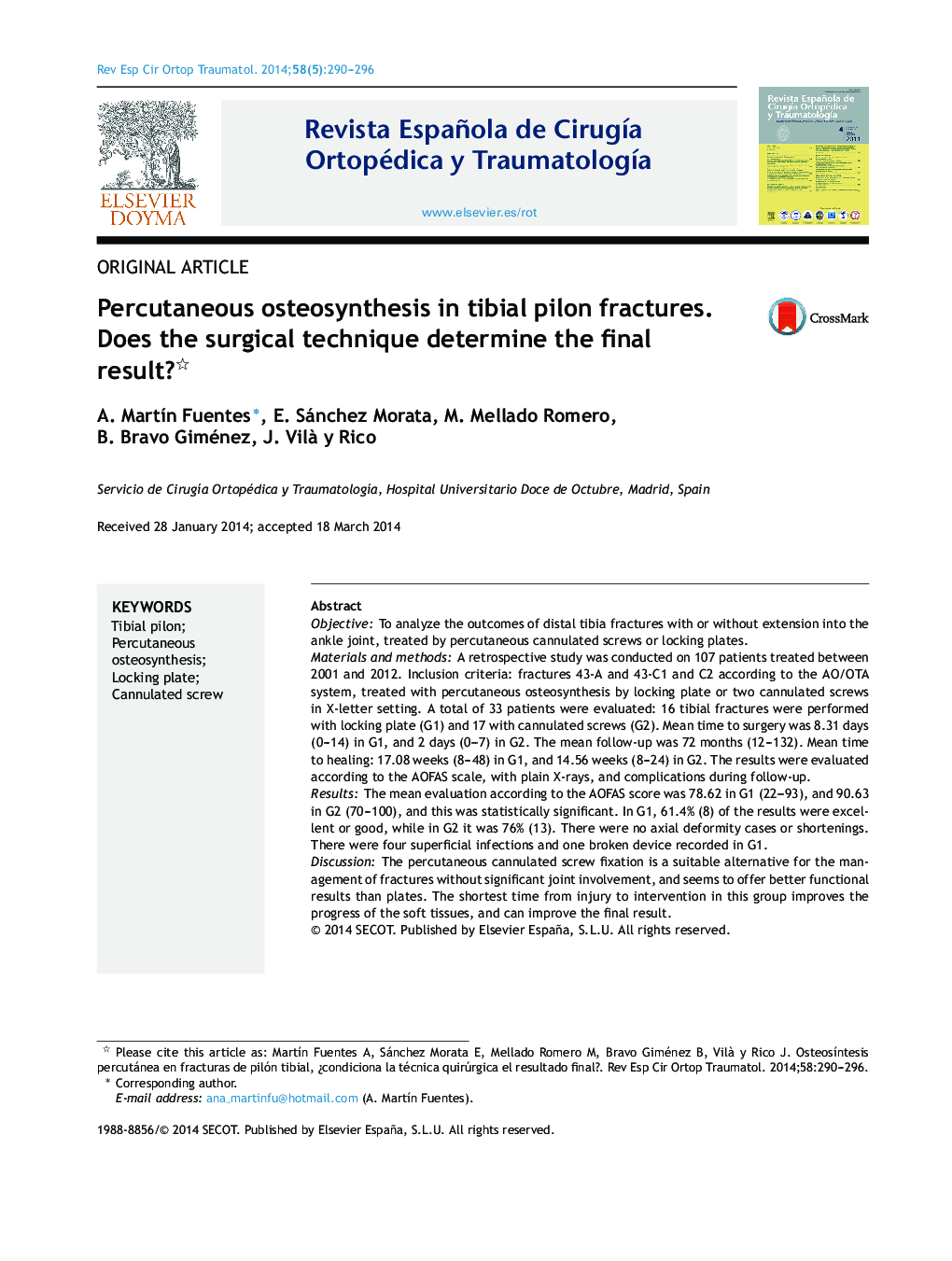| کد مقاله | کد نشریه | سال انتشار | مقاله انگلیسی | نسخه تمام متن |
|---|---|---|---|---|
| 4087263 | 1268026 | 2014 | 7 صفحه PDF | دانلود رایگان |

ObjectiveTo analyze the outcomes of distal tibia fractures with or without extension into the ankle joint, treated by percutaneous cannulated screws or locking plates.Materials and methodsA retrospective study was conducted on 107 patients treated between 2001 and 2012. Inclusion criteria: fractures 43-A and 43-C1 and C2 according to the AO/OTA system, treated with percutaneous osteosynthesis by locking plate or two cannulated screws in X-letter setting. A total of 33 patients were evaluated: 16 tibial fractures were performed with locking plate (G1) and 17 with cannulated screws (G2). Mean time to surgery was 8.31 days (0–14) in G1, and 2 days (0–7) in G2. The mean follow-up was 72 months (12–132). Mean time to healing: 17.08 weeks (8–48) in G1, and 14.56 weeks (8–24) in G2. The results were evaluated according to the AOFAS scale, with plain X-rays, and complications during follow-up.ResultsThe mean evaluation according to the AOFAS score was 78.62 in G1 (22–93), and 90.63 in G2 (70–100), and this was statistically significant. In G1, 61.4% (8) of the results were excellent or good, while in G2 it was 76% (13). There were no axial deformity cases or shortenings. There were four superficial infections and one broken device recorded in G1.DiscussionThe percutaneous cannulated screw fixation is a suitable alternative for the management of fractures without significant joint involvement, and seems to offer better functional results than plates. The shortest time from injury to intervention in this group improves the progress of the soft tissues, and can improve the final result.
ResumenObjetivoAnalizar los resultados del tratamiento de las fracturas de tibia distal con o sin afectación intraarticular, tratadas con osteosíntesis percutánea mediante placas o tornillos canulados.Material y métodoEstudio retrospectivo de 107 pacientes intervenidos entre 2001 y 2012. Criterios de inclusión: fracturas 43-A y 43-C1 y C2 según la clasificación AO, tratadas con osteosíntesis percutánea mediante placa bloqueada o 2 tornillos canulados en aspa. Se evaluaron 33 pacientes: 16 casos fueron sintetizados con placa bloqueada (G1) y 17 con tornillos canulados (G2). El tiempo medio hasta cirugía fue de 8,31 días (0-14) en G1 y de 2 días (0-7) en G2. La media de seguimiento fue de 72 meses (12-132). Tiempo medio hasta consolidación: 17,08 semanas (8-48) en G1 y 14,56 semanas (8-24) en G2. Los resultados se evaluaron según la escala AOFAS, radiografías simples y complicaciones durante el seguimiento.ResultadosLa valoración media según la AOFAS fue de 78,62 en G1 (22-93) y 90,63 en G2 (70-100), siendo esta diferencia estadísticamente significativa. En G1 el 61,4% (8) de los resultados fueron excelentes o buenos, mientras que en G2 lo fueron el 76% (13). Ausencia de casos con deformidad axial y acortamientos. Se registraron 4 infecciones superficiales y una rotura de material en G1.DiscusiónLa osteosíntesis percutánea con tornillos canulados supone una alternativa adecuada para el manejo de fracturas tibiales sin gran componente articular con mejores resultados que la síntesis con placas. El menor tiempo desde el traumatismo hasta la intervención en este grupo mejora la evolución de partes blandas, siendo significativo en el resultado final.
Journal: Revista Española de Cirugía Ortopédica y Traumatología (English Edition) - Volume 58, Issue 5, September–October 2014, Pages 290–296